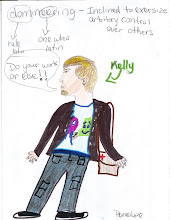Covering
“Welcome to the Hellmouth” and “The Harvest,” in which we meet beloved
characters. Sort of.
I’ve never particularly considered BtVS’s early episodes especially
required viewing. Most of the truncated first season I’ve never seen, and
though I have seen these two (Netflix helpfully confirms), I didn’t remember
much about them. There were some fights with vampires, probably involving the
Master? Seems like a safe assumption. And really, after a fresh viewing, that’s
all it is. Most of the time is spent establishing concept, characters and
locale, and the concept, at least, is right there in the title. We needed to
see the establishment, obviously, but, still, it doesn’t require a lot of
front-loaded mythos. Vampires. Chosen slayer of said vampires. And there’s a
dimensional portal. There’s also some talk of the Slayer possessing more arcane
quasi-mystical powers that the show never went too deep on, which may have been
an abandoned plotline, but more likely was just a nice character beat.
Isn’t it important to know who the
characters are, though, so shouldn’t you start with the first episode? I’ve had
this discussion, and I think BtVS
makes a strong case for “not always.” Especially in the early offerings,
everyone has a simple enough archetype and role that they are instantly
understandable. That may sound like a backhanded insult, but it’s not, I think
it’s actually a pretty good thing, at least when it comes to sharing the Buffy
experience—you can encourage people to jump straight to the good stuff. One
downside of the age of extensive serialization is that you often have to tell
people to watch a lot of dreck so they’ll have the proper context when things
get good. Here, wise mentor. Goof. Shy outcast. Queen bee. If you knew nothing
of the show, and just had a cast photo and those descriptions, you could pick
out who was who.
And besides, as is the nature of
pilots, just about everyone is just slightly askance from what I was accustomed
to. Willow had a few lines that sounded like they were intended for an outcast
just a touch more bitter and acerbic than Hannigan would ever play her. Xander
probably wasn’t supposed to be quite this much of a whiney dick at this point
in time (or, plenty will argue, he was). Cordelia is basically just a joke, and
quite a bit dumber than I was used to. Giles is pretty much Giles, though it
was odd, if not unexpected, to see he and Buffy at this disrespectful stage.
Oh, and apparently Xander and Willow had a bestie named Jesse, but since I didn’t
remember Eric Balfour (he was a thing in the 90’s?) was ever a part of the
show, it was pretty apparent he’d be dead meat before too long.
The characters that were the most
off, however, were the vampires. Granted, I’m pretty sure the Master doesn’t
cover himself in glory as a Buffy baddie. I believe it’s later said that Angel
was putting on a show, but it’s straight up bizarre watching a character who
sturmed and dranged his way broodfully across two shows acting the part of a
roguish and rakish ally of dubious motive, so bizarre I wonder if there was any
plan at all for the character at this point. I’d venture not, because here
Darla is a simpering and inept hench, outranked by Luke who I don’t think ever
gets mentioned again (not the biggest loss), without a trace of towering
sociopath matriarch.
Buffy herself, however, is on point,
from the resentment of her burden to her eagerness to take it on so others don’t.
After all, it is her show, it isn’t called The
Scoobies, so she better be on point. That character moment I mentioned
earlier is hers, as she eschews the traditional powers and roles of the Slayer
and sniffs out a vampire based on his outdated clothes (though, to be frank,
they didn’t look all that much more outdated than anyone else, though I guess
it was more how he was wearing than what). She’s confident but nervous, glib
and inventive, and yearns to be trivial but tragically can’t. At least in these
first two episodes, Buffy is clear.
The scaffolding of dominant themes
also get built. Buffy is introduced already struggling with normalcy (on her
Campbellian Hero’s Journey, she is firmly in Rejecting the Call when we first
meet her, which is interesting structurally—her Call to Adventure happens off-screen,
or in the movie, I guess). High school’s absurdities and cruelties rear their
head. Demonology has a very clear Lovecraftian tinge (and the Old Ones get
their names dropped). Jesse’s transformation allows him to darkly act on his
male entitlement. The monsters are often wry and put-upon. Willow and Xander
witness how the norms all around them rationalize and ignore what they’ve seen
in ways Douglas Adams often also saw.
Despite season 1’s reputation, I
didn’t find these two episodes distractingly cheap-looking. Maybe it’s the fact
that they’re so old now, or maybe I’ve become inured from so many old Doctor Whos and really old Doctor Whos,
but despite some awkward sequences, some less than inspiringly staged action,
and pre-HD cameras, these two looked ok. Their score is pretty terrible, but
visually, this isn’t unwatchable. In a way, the abrupt transitions to vampire
shape, with as little expensive CG morphing as possible, is a more horror movie
move than what the show would later adopt, as if they always appear to be
monsters, and you just refuse to see them until it’s too late.
Ultimately, I came away from “Welcome
to the Hellmouth” and “The Harvest” feeling like the show wasn’t having to
waste a lot of effort in doing what it wanted to do. And for first episodes,
that’s a very good sign.


No comments:
Post a Comment